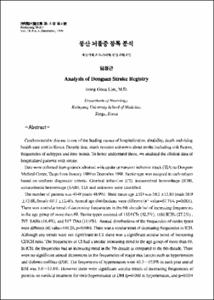동산 뇌졸증 등록 분석
- Keimyung Author(s)
- Lim, Jeong Geun
- Department
- Dept. of Neurology (신경과학)
- Journal Title
- Keimyung Medical Journal
- Issued Date
- 1999
- Volume
- 18
- Issue
- 4
- Keyword
- Stroke; Age distribution; Stroke subtypes; Risk factors
- Abstract
- Cerebrovascular disease is one of the leading causes of hospitalization, disability, death and rising health care cost in Korea. Despite that, much remains unknown about stroke including risk factors, frequencies of subtypes and time trends. To better understand these, we analized the clinical data of hospitalized patients with stroke.
Data were collected from patients admitted with stroke or transient ischemic attack(TLA) to Dongsan Medical Center, Taegu from January 1989 to December 1998. Stroke type was assigned to each subject based on uniform diagnostic criteria. Cerebral infarction (CI), intracerebral hemorrhage (ICH), subarachnoid hemorrhage (SAH), TIA and unknown were identified.
The number of patients was 4549 (male 48.9%). Their mean age ±SD was 59.2±13.80 (male 58.9±12.68, female 60.7±12.46). Annual age distributions were different (χ²value=67.714, p=0.001). There was a secular trend of decreasing frequencies in the 6th decade but of increasing frequencies in the age group of more than 69. Stroke types consisted of 1854 CIs(42.5%), 1186 ICHs(27.2%), 797 SAHs(18.4%), and 517 TLAs(11.9%). Annual distributions of the frequencies of stoke types were different (χ2 value=141.28, p=0.000). There was a secular trend of decreasing frequencies in ICH. Although any trends were not significant in CI, there was a significant secular trend of increasing CI/ICH ratio. The frequencies of CI had a secular increasing trend in the age group of more than 69. In ICH, the frequencies had an increasing trend in the 7th decade as compared to the 6th decade. There were no significant annual differences in the frequencies of major risk factors such as hypertension and diabetes mellitus (DM). The frequencies of hypertension were 43.3∼57.9% in each year and of DM was 5.6∼12.6%. However there were significant secular trends of increasing frequencies of patients on medical treatment for their hypertension or DM (p=0.000 in hypertension, and p=0.034 in DM).
There was a trend of increase in the mean age of stroke which might be caused by the increase of the life expectancy over the past 10 years. Despite of the similar annual frequencies of major risk factors, the stroke types and the CI subtypes revealed different annual distributions. The improvement in medical management for hypertension and DM might bring out those results. It was also an important result that the frequency of ICH was high in the 7th decade in these years, as well as was still higher than that of the well developed western countries. Genetic, dietary, and environmental factors may play important roles in this difference. These results should be considered in prevention of stoke.
- Alternative Title
- Analysis of
Dongsan Stroke Registry
- Keimyung Author(s)(Kor)
- 임정근
- Publisher
- Keimyung University School of Medicine
- Citation
- 임정근. (1999). 동산 뇌졸증 등록 분석. Keimyung Medical Journal, 18(4), 463–474.
- Type
- Article
- Appears in Collections:
- 2. Keimyung Medical Journal (계명의대 학술지) > 1999
1. School of Medicine (의과대학) > Dept. of Neurology (신경과학)
- 파일 목록
-
-
Download
 18-463.pdf
기타 데이터 / 540.44 kB / Adobe PDF
18-463.pdf
기타 데이터 / 540.44 kB / Adobe PDF
-
Items in Repository are protected by copyright, with all rights reserved, unless otherwise indicated.